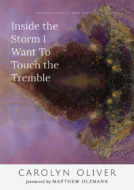 Carolyn Oliver
Carolyn Oliver
Inside the Storm I Want to Touch the Tremble
The University of Utah Press
Reviewer: Vivian Wagner
The title of Carolyn Oliver’s Inside the Storm I Want to Touch the Tremble is a kind of riddle that gives a road map for the collection itself. This is a collection about traumatic storms, and about the attempt to find beauty—“the tremble”—in the midst of those storms. These are complex and multilayered poems that require multiple readings. Ultimately, though, the poems repay the reader for close attention, and inside their storms the reader, too, might start to find the tremble.
The collection opens with a poem that gives the collection its title: “My Son Asks if I Would Rather Live in a House Infested by Bees or a House Infested by Koalas.” It weighs the danger posed by bees against the presumed safety of koalas. Living with koalas would, we hear, involve “koalas on the stairs, lamps turned boughs, / menthol in the mouth”—nothing too terrifying, in other words. The bees, though, have a certain dark appeal, despite their danger, and the speaker says that sometimes “inside the storm I want to touch the tremble / of a colony warming its queen.” It’s here that the collection begins exploring the intersections of danger and beauty, and trauma and survival, with the suggestion that a safe path might be neither desirable nor possible.
The book is divided into six sections, each of which seems to explore different stages of a life and the varying traumas and survival responses associated with those periods. The first section focuses on origin stories, opening with a poem entitled “Eve Grinds Pigments for Artemisia Gentileschi.” This poem, with its references to stones and minerals that can be ground to make pigments, offers a glimpse into the geology of the collection’s emotional landscape. The speaker is questioned by a voice that tries to understand her relationship with lapis, bloodstone, cinnabar, and malachite, parts of the earth that can be crushed for the sake of art. The self, the speaker suggests, can also be bruised for the sake of creation. In answer to the query about lapis, for instance, “did you ever contemplate crushing such a prize?” the speaker answers, “Only as often as I’ve wanted to dissolve.” It’s a moment of realization that the violence of trauma can prepare a self for making art and thereby surviving.
“Geography Lessons,” a poem in the second section, also looks at the connection between interior and exterior landscapes, opening with an exploration of the permeable boundary between the two: “Vomiting on highway shoulders / in eleven states, brought low because / my body does not know its own interior….” Here the speaker struggles to find steadiness in nature, in Queen Anne’s lace and a red-tailed hawk, even as she’s vomiting along highways. It’s a poem about finding some kind of peace in the midst of traumatic sickness, when vomiting becomes at least a way of “marking the world,” and perhaps the only art possible at the moment.
The middle sections focus on connections or attempts at connection in early adulthood and ultimately on the tentative beginnings of healing in relationships. “Epithalamion with Missing Groom” in the third section, looks at a missed connection and the attempt to make meaning when faced by loss: “By noon I will be wedded to a particular absence.” This is a subdued and yet frighteningly traumatic event, as the speaker has come to understand the importance of finding and nurturing connection: “After the ceremony, quiet. Not peace.”
The fourth section explores the slow and steady strengthening of relationships that might finally start to provide space for healing. A prose poem in the fourth section entitled “After the Exhibit,” for example, looks at the fragility of a relationship that nonetheless provides a tenuous steadiness: “the frigid air glass between us, you tried to explain to me how it was for you last night.” It’s a moment of simultaneous connection and distance, and yet it provides a space for care and compassion in the midst of the swirling storm of traumas. The poem ends with this image of fierce and abiding love: “all along it’s been you: you, you are the poet who wields lenses and frames, whose light comes in strands through windows and hours.” In the geography of this collection, this light is particularly meaningful, illuminating the shadows of traumatic experiences and in so doing, bringing a welcome sense of awareness and peace.
“Love Poem with Fiddlehead Ferns” likewise offers an image of the hope and healing that might be found in connection: “the gift is your mouth, / tulip soft at my ear. Wet with spring.” The beloved here offers something the speaker in many of these poems has been searching for: interrelatedness and sensuality. It also harkens back to the notion of touching the “tremble” in the heart of the storm, though here the tremble is within the speaker’s own body.
The last several sections focus on periods of maturity later in life, with the poems finding and creating spaces for continued healing and growth. Here, too, comes an added element of community as a way to survive the storms of a life. In “Midsummer,” for instance, the speaker envisions mussel beds: “Again and again the cold sea slaps / the rocky beds of creatures exposed / and threading themselves together.”
This deepening understanding of the role community can play in helping individuals survive is threaded through many of poems in these later sections, where interconnectedness between living beings and each other—and living beings and the earth—becomes a central theme. The prose poem “The Public Is Invited to See the Yew Trees in Full Fruit at This Time” looks at the supportive role the earth itself can play in recovery and survival: “Heartwood side in, sapwood out, toward the enemy. Their arrows flecked the sky like mica in granite. The yews rose again out of the air.”
The collection’s final poem, “Midlife,” looks at endurance in middle age and the way it might require a radical acceptance of loss:
… I might have learned
to accept some hard things:
absence, mainly,
but frailty too, and censure.
The poem also echoes some of the earlier images in the collection, such as Eve’s and Cezanne’s apples, but here they’re spilled, “scampering over the lawn / with something like life.” It ends by returning to the bees of the first poem, with their simultaneous danger and appeal, and yet here they’re refigured as valiant workers: Let me be born again, / here with the laboring bees / in the last throes of their valiance.
In a collection about trauma and survival, these final lines offer a hope that’s neither false nor saccharine, but rather one born of the tremble and buzz of difficulty and loss.

